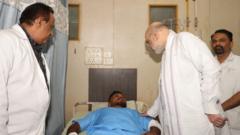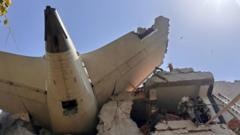The investigation into the crash of Air India's Boeing 787-8 Dreamliner that claimed 241 lives is ongoing, with experts evaluating possible reasons behind the incident, including double engine failure, bird strikes, and flaps not being extended during takeoff.
Investigators Probe Air India Crash: Theories Emerge After Tragic Downing of Flight AI171

Investigators Probe Air India Crash: Theories Emerge After Tragic Downing of Flight AI171
As aviation experts analyze the catastrophic crash of Flight AI171 shortly after takeoff in Ahmedabad, various potential causes are being explored, including engine failure and bird strikes.
The tragic downing of Air India's Flight AI171, which took place just moments after its takeoff from Sardar Vallabhbhai Patel International Airport in Ahmedabad, has left investigators and families in mourning. With 241 lives lost—228 passengers and 13 crew members—the Boeing 787-8 Dreamliner crash marks a devastating moment in aviation history, being the first fatal incident involving this aircraft model since its entry into service in 2011.
Initial analyses of the event suggest the period immediately after takeoff was fraught with challenges, compelling the involved parties—including Indian, US, and UK aviation experts—to delve deeply into the possible causes of the crash. Footage from the final moments of the flight shows the aircraft struggling to gain altitude shortly after takeoff, a situation that prompted a mayday call from the cockpit.
The Flight, operated by seasoned Captain Sumeet Sabharwal and co-pilot Clive Kundar, encountered difficulties almost immediately as it ascended, carrying around 100 tonnes of fuel. Notably, reports suggest that the flight only managed to remain airborne for 30 seconds before plummeting into a densely populated area. Eyewitness accounts provided chilling details of the plane's descent and subsequent explosion, which reportedly devastated several residential buildings.
Speculation surrounding the cause has pointed towards an extraordinary double engine failure, an extremely rare occurrence that would severely limit the crew’s ability to react effectively. Meanwhile, experts are examining whether crucial safety systems—such as the Ram Air Turbine (RAT)—were deployed, indicating a major failure of the plane's primary engines.
In addition to mechanical failures, the existing threat posed by birds in the Ahmedabad region has come under scrutiny. The airport has a notorious history of bird strikes, raising concerns about whether a bird collision could have led to this catastrophic incident.
Another theory relates to the airplane's flaps, which are pivotal in generating lift during takeoff. If they were not extended properly, this could have caused a dangerous performance issue, particularly under the hot and less dense air conditions that day.
As experts begin to piece together the sequence of events, data from the black box will be crucial for establishing a definitive cause. The airline is cooperating fully with investigators, and both Boeing and engine manufacturer GE Aerospace are committed to providing assistance. With the tragedy provoking intense scrutiny and debate within the aviation community, the pursuit of answers continues in hopes of preventing future disasters.





















